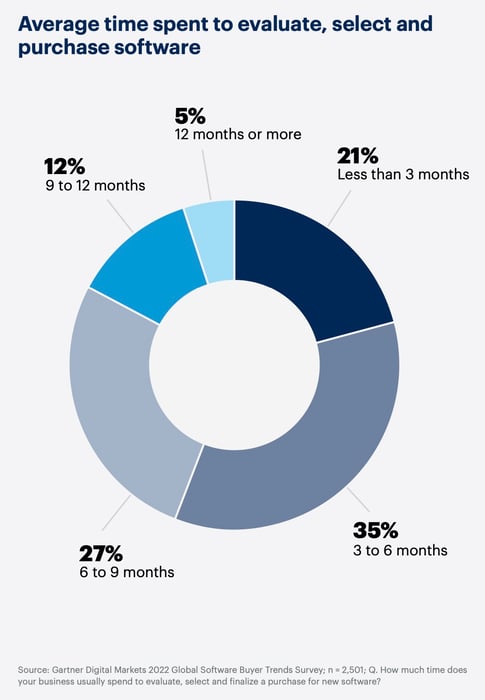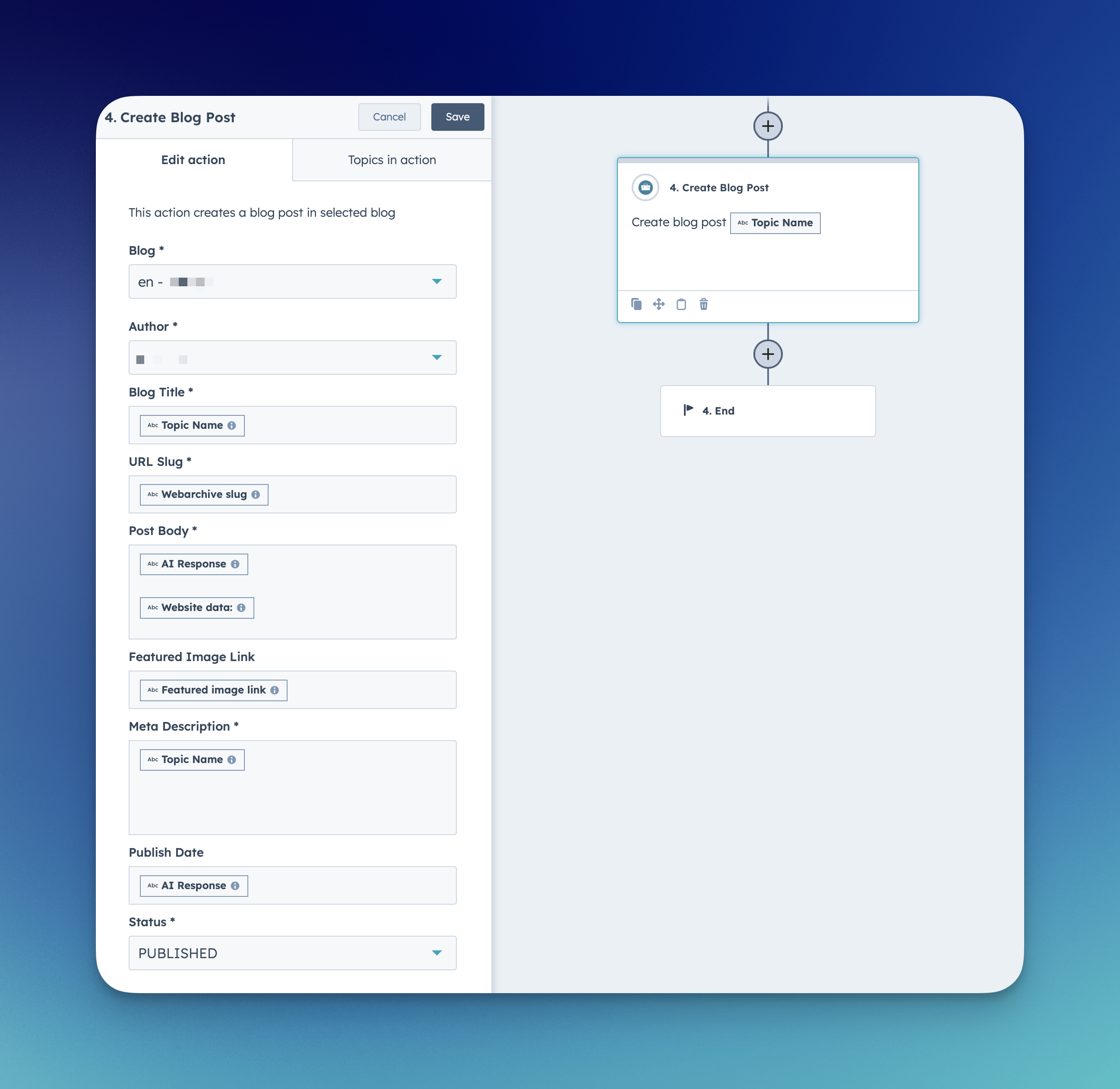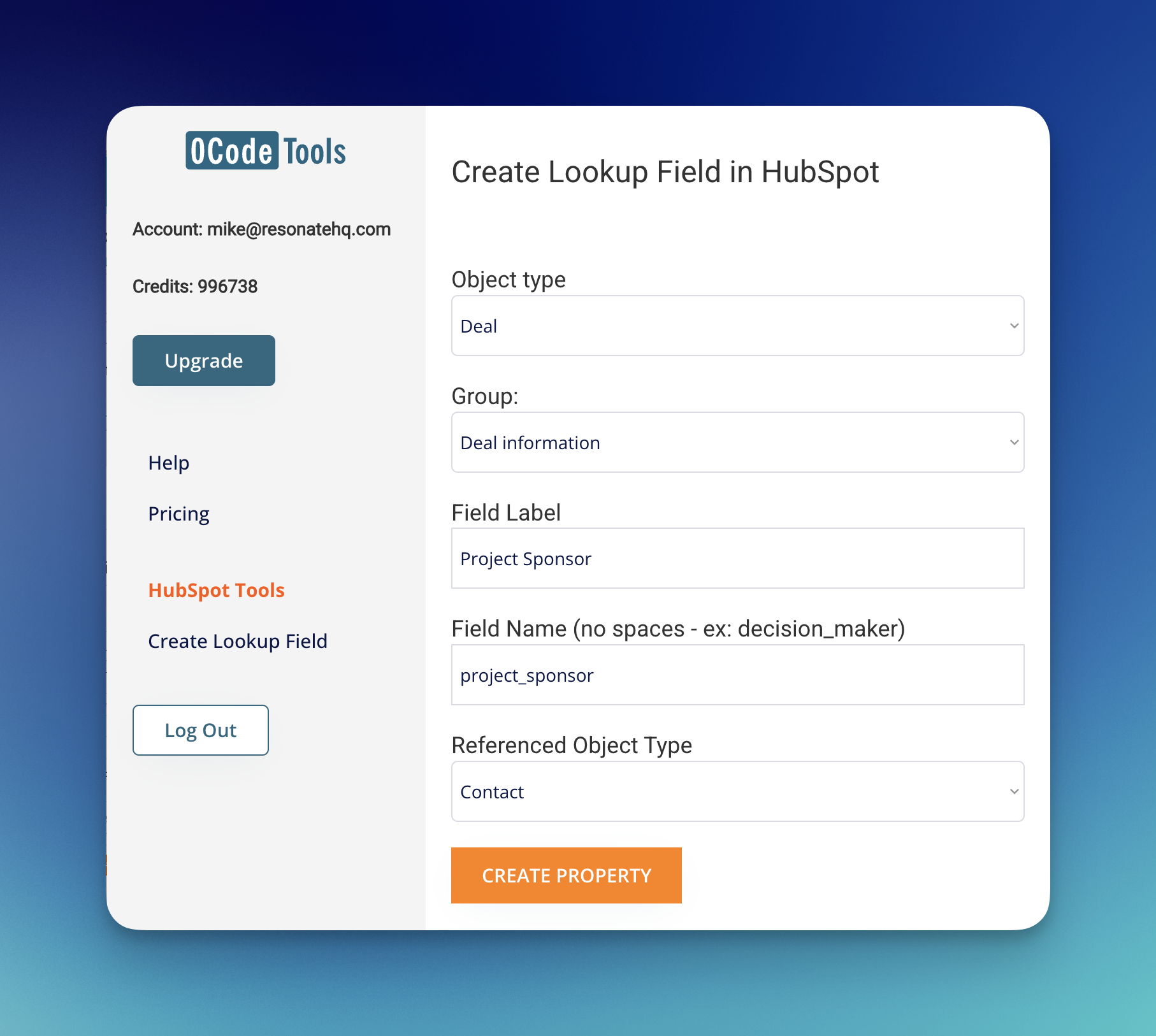
Lifecycle marketing is a concept that focuses on engaging customers and prospects at every stage of their journey, from the moment they become aware of a product or service to the time they become advocates and refer others. It is a comprehensive approach that takes into account the needs of the customer at each stage of the cycle and tailors the marketing strategy accordingly.
Lifecycles can vary significantly in duration. Short lifecycles may span a few weeks or months and longer lifecycles can go up to several years. The length of a lifecycle depends on the industry, product type, and customer base. For example, B2B software and technology products often have longer lifecycles of 6+ or 9+ months.
The purchase process of B2B technology can take more than 3 months. Many factors contribute to this, such as the involvement of many stakeholders. Additionally, buyers prefer to do their own research before making a purchase. This can make it hard for them to reach a consensus about key priorities. Software and SaaS providers can help buyers navigate the purchase process by providing helpful resources, such as trial periods. Once buyers are familiar with their options, they prefer to take control of the purchase process by doing their own research and seeking advice from internal IT experts. This involves researching different software solutions and comparing providers online. To help buyers make an informed decision, software providers should offer valuable resources and tools.

B2B technology lifecycle benchmarks typically span four stages: discovery, evaluation, purchase, and loyalty. During the discovery stage, customers become aware of a product or service and begin researching it. During the evaluation stage, customers compare products and services in order to make an informed decision. During the purchase stage, customers make their decision and buy the product or service. Finally, during the loyalty stage, customers use the product or service and become advocates, recommending it to others.
READ ALSO: Ultimate Marketing Guide for B2B Software and Technology Companies
Awareness or Discovery - In the discovery stage, customers become aware of a product or service and begin researching it, as well as its competitors. This is the stage where companies should focus on content marketing, SEO, paid search, and social media to attract potential customers. Content can include blog posts, videos, giveaways, and interactive challenges.
Consideration or Evaluation - During the evaluation stage, customers compare products and services in order to make an informed decision. Companies should focus on providing personalized, educational content to help customers make their decisions. Content can include comparison sheets, feature breakdowns, user testimonials, and webinars.
Purchase - During the purchase stage, customers make their decision and buy the product or service. Companies should focus on optimizing their online checkouts to make sure the process is frictionless and easy to complete. Content can include discounts, exclusive offers, and gift cards.
Loyalty - Finally, during the loyalty stage, customers use the product or service and become advocates, recommending it to others. Companies should focus on providing excellent customer service and engaging content. Content can include tutorial videos, customer success stories, and loyalty programs.
Tools and channels used in lifecycle marketing include both traditional and digital avenues.
Traditional methods include direct mail, print advertising, radio and television, and in-store promotions.
Digital tools and channels consist of email, website marketing, social media, search engine optimization (SEO), content marketing, and retargeting.
Email is a common tool used in lifecycle marketing. It allows businesses to send personalized communications and content to customers or prospects depending on their stage in their customer journey. It can be used to send informational content, product information, offers, discounts, and more.
Websites of course are essential for lifecycle marketing. It’s important to design your website in a manner which guides potential customers through the different stages of their lifecycle journey. This can include providing educational content and resources, offering discounts or promotions, and creating a sales funnel which takes customers from awareness to conversion.
Social media is a great way to connect with customers and prospects in their journey. It can be used to introduce new customers to the business, provide content which is helpful or entertaining, and offer exclusive discounts or promotions. It’s important to identify which platforms your target audience is active on and tailor your content and messaging appropriately.
Search engine optimization (SEO) is the process of optimizing your website, content, and other assets to increase visibility and generate organic traffic. This is an important tool for lifecycle marketing as it can be used to reach potential customers who are actively looking for your products or services.
Content marketing is another important tool for lifecycle marketing. It involves creating content which is helpful, educational, or entertaining for your target audience in order to build trust and establish your business as a trusted authority for your specific industry.
Retargeting is a form of digital advertising which uses cookies to track users’ browsing activities. It allows you to show ads to people who have previously visited your website or interacted with your business in some way. This helps to increase visibility and re-engage potential customers who may have dropped off in their journey.
By utilizing the different tools and channels of lifecycle marketing, businesses can increase customer engagement, build brand loyalty, and ultimately, increase sales.
Lifecycle marketing for B2B buyers starts with the discovery phase. During this stage, the priority of the marketing and content strategy is to introduce potential prospects to the brand and its offerings. The goal of this stage is to create awareness and start generating qualified leads. Content during this stage should be aimed at introducing the product or service and convincing potential customers of the value it offers. These content pieces include blog posts, videos, infographics, whitepapers and webinars.
The next stage is evaluation, where prospects that have been exposed to the company’s brand and offerings take the next steps to learn more. During this stage, sales teams should be providing personalized outreach and content that covers the product’s features and benefits in detail. Content pieces used during this stage include case studies, product datasheets and comparison sheets to help prospects evaluate their options.
The third stage is purchase. During this stage, the marketing team should be providing prospects with personalized messaging and content that pushes them closer to making a purchase decision. This includes custom offers, discount codes, and easy payment options. Content pieces used during this stage could include customer reviews, testimonials, and after-sales support materials.
The final stage is loyalty. During this stage, marketing teams should be attempting to nurture customer relationships, encouraging customer loyalty and repeat purchases. Content used during this stage should include newsletters, promotion messages, loyalty programs, and customer feedback surveys.
Provide potential customers with product demonstrations and complimentary trials to facilitate faster buying decisions. Demonstrate your expertise in the industry by creating educational blogs, e-books, videos, and podcasts. This will establish you as a dependable source of information throughout the purchase process. Additionally, use buyer intent data to ensure you are delivering the most suitable content at the appropriate time.
In conclusion, B2B organizations should be utilizing lifecycle marketing and content strategies to ensure they reach prospects at each stage of the customer journey. Content pieces should be tailored to provide information that is relevant to a prospect’s stage in the buying cycle and encourage them to move further through the sales funnel. This will help companies form and nurture long-term relationships with their customers, driving customer loyalty and repeat purchases.
Welcome email sequences are an essential part of lifecycle email marketing for B2B tech companies and SaaS vendors. This type of email should be sent as soon as a new customer signs up for a free trial or subscribes to a premium service. The welcome email sequence should include a personalized thank you message for signing up, an introduction to the product or service and its features, as well as any setup instructions necessary for the customer to get the most out of their experience.
Onboarding emails are sent to help customers become familiar with the product or service. This type of email should provide customers with introductory or tutorial information in order to get them up to speed quickly. These emails should also contain customer success stories, customer tips, and other relevant information to increase engagement.
Webinar sequences are a great way to introduce customers to the product or service and provide them with an opportunity to ask questions directly. These emails should include an introduction to the webinar topic and the benefits of attending, as well as a link or instructions to join the live webinar.
Free trial sequences are a common lifecycle email marketing strategy for B2B tech companies and SaaS vendors. These emails should contain a short explanatory message about the product or service, a link to sign up for the free trial, and, as applicable, setup instructions for the customer to get the most out of their experience.
Nurturing emails are an important part of tech-companies email marketing. This type of email should be sent periodically to keep customers informed about the latest product or service updates, as well as any special offers or discounts. These emails should also contain relevant and timely information about the industry to keep customers engaged.
Re-engagement emails are a great way to keep customers engaged with your product or service. This type of email should include a personalized message about how the customer can benefit from their subscription, as well as special offers and discounts.
Feedback and upselling emails are a great way to stay in touch with customers and offer them additional value. These emails should include a customer survey asking for feedback on their experience with the product or service. It should also include offers or discounts for upgraded or additional products and services.
Content personalization is used to create an experience that is more meaningful and relevant to each customer, increasing the chances of them engaging with the brand.
Content personalization starts with understanding the customer’s lifecycle stage and crafting content that best suits their needs. It is important to understand their interests, needs, and preferences so that the content can be tailored accordingly. For example, customers in the awareness stage of the lifecycle may be more interested in educational content, while customers in the consideration stage may be more interested in content that speaks to the benefits of the product or service.
Once the content is personalized to the customer’s stage in the lifecycle, it should be delivered in an engaging and timely manner. This could include emails, webinars, videos, blog posts, social media posts, and more. Additionally, content should be tracked to measure its effectiveness. Tracking metrics such as click-through rates, shares, and conversions will help to determine the success of the content and inform future content personalization efforts.
It is quite easy to be confused for HubSpot users as one of the key concepts of HubSpot is Contact/Company Lifecylce Stage.
Lifecycle marketing stages and lifecycle stages in HubSpot CRM are two different concepts with different objectives. Lifecycle marketing stages refer to various stages of a customer journey including such stages as awareness/discovert, consideration/evaluation, purchase, and loyalty. These stages help marketers develop customer-centric strategies and campaigns that are tailored to customers’ needs, including the right content and offers at each stage.
Lifecycle stages in HubSpot CRM, on the other hand, is a feature that helps segment contacts into different lifecycle stages, such as lead, marketing qualified lead, sales qualified lead, customer, and others. This way, companies can nurture their customer relationships in an efficient and effective manner. By using these two tools together, companies can gain a better understanding of the customer journey, track customer progress, and tailor their marketing campaigns to the individual customer. This in turn can help them increase customer engagement and retention.

Learn exactly how to connect a custom (root or sub) domain, update DNS records, and launch your HubSpot ...

We have just introduced a new workflow action for automatically creating and publishing blog posts in Hu...

If you’ve ever worked with Salesforce, you know how powerful “lookup fields” can be for connecting recor...